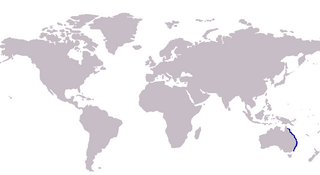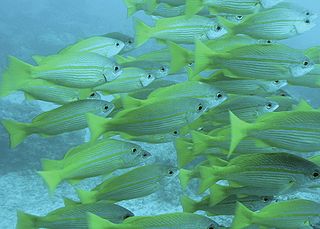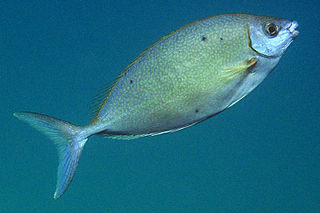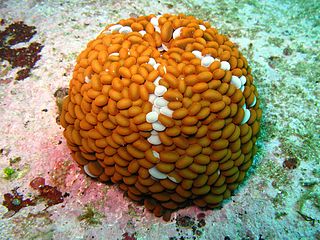
Jean René Constant Quoy was a French naval surgeon, zoologist and anatomist.
The Dalatiidae are the family of kitefin sharks of the order Squaliformes. Members of this family are small, under 2 m (6.6 ft) long, and are found worldwide. They have cigar-shaped bodies with narrow heads and rounded snouts. Several species have specialized bioluminescent organs. Though eight genera are in this family, four of them are monotypic.

The pygmy shark, the second-smallest of all the shark species after the dwarf lanternshark, is a squaliform shark of the family Dalatiidae, the only member of the genus Euprotomicrus. Their lengths are up to about 25 cm (10 in) for females and about 22 cm (8.7 in) for males.

The marbled parrotfish, also known as the seagrass parrotfish, is a species of marine ray-finned fish, a parrotfish from the family Scaridae and is the only known member of the genus Leptoscarus. It has a wide Indo-Pacific distribution and is also found in the southeastern Atlantic Ocean. It is a coastal species found in beds of sea grass and seaweed.

Scorpaenodes is a widespread genus of marine ray-finned fish belonging to the family Scorpaenidae, the scorpionfishes. The fishes in this genus are found to the Atlantic, Indian and Pacific Ocean.

The trumpeter whiting, Sillago maculata, is a common species of coastal marine fish of the smelt-whiting family, Sillaginidae. The trumpeter whiting is endemic to Australia, inhabiting the eastern seaboard from southern New South Wales to northern Queensland. The species is found in bays, estuaries, coastal lakes and mangrove creeks on silty and muddy substrates in waters ranging from 0 to 30 m deep, occasionally inhabiting sandy and seagrass beds.

Lutjanus is a genus of marine ray-finned fish, snappers belonging to the family Lutjanidae. They are found in the Atlantic, Indian, and Pacific Oceans. They are predatory fish usually found in tropical and subtropical reefs, and mangrove forests. This genus also includes two species that only occur in fresh and brackish waters.

Coris gaimard, the yellowtail wrasse or African coris, among other vernacular names, is a species of wrasse native to the tropical waters of the central Indian Ocean and the western Pacific Ocean, from Christmas Islands and Cocos Keeling Islands to the Society Islands, Hawaii, and from Japan to Australia. It is an inhabitant of coral reefs, being found in areas that offer a mix of sand patches, rubble, and coral at depths from 1 to 50 m. This species can also be found in the aquarium trade and is popular species for display in public aquaria.

The crowned nudibranch is a species of dorid nudibranch. It is a marine gastropod mollusc in the family Polyceridae.
Mexichromis lemniscata is a species of colourful sea slug or dorid nudibranch, a marine gastropod mollusk in the family Chromodorididae.

The streamlined spinefoot, also known as the forktail rabbitfish, schooling rabbitfish or silver spinefoot, is a species of marine ray-finned fish, a rabbitfish belonging to the family Siganidae. It is found in the Indo-Pacific region.

Brachaluteres is a genus of filefish of the family Monacanthidae. The genus name "Brachaluteres" is derived from the Greek brachys and the Latin luteus. Fish of the genus occur in the tropical waters of the Western Pacific Ocean.

Phlyctenactis tuberculosa, common name the wandering sea anemone or swimming anemone, is a species of sea anemone in the family Actiniidae. It is native to shallow seas around Australia and New Zealand. It was first described by the French zoologist Jean René Constant Quoy and the French naturalist Joseph Paul Gaimard. They were naval surgeons in the French Navy who amassed sizable collections of various organisms while traveling.

Acanthaluteres is a genus of filefishes native to the Indian and Pacific Oceans.

Meuschenia is a genus of filefishes native to the coastal waters around Australia. There are eight species from the temperate southern half of Australia.

Ocypode convexa, commonly known as the golden ghost crab, or alternatively the western ghost crab or yellow ghost crab, is a species of ghost crabs endemic to the coast of Western Australia, from Broome to Perth. They are relatively large ghost crabs, with a carapace growing up to 45 mm (1.8 in) long and 52 mm (2.0 in) wide. They are easily recognisable by their golden yellow colouration. Like other ghost crabs they have box-like bodies with unequally sized claws. They also have large eyestalks with the cornea occupying most of the bottom part.

Lutjanus vitta, the brownstripe red snapper, brownstripe snapper, broadband seaperch, brownstripe seaperch, one-band sea-perch, one-lined snapper or striped seaperch, is a species of marine ray-finned fish, a snapper belonging to the family Lutjanidae. It is native to the western Pacific and Indian Oceans.

Sepioteuthis australis, commonly known as the southern calamari or the southern reef squid, is a species of reef squid that is native to oceans off the coast of Australia and New Zealand. This species is caught commercially by trawling, as bycatch in the prawn fishing industry and by recreational anglers.
Doriopsilla aurea is a species of dorid nudibranch, a colourful sea slug, a shell-less marine gastropod mollusc in the family Dendrodorididae.

Kyphosus vaigiensis, the brassy chub, brassy drummer, long-finned drummer, low-finned drummer, Northern silver drummer, Queensland drummer, Southern drummer, blue-bronze sea chub, brassy rudderfish, yellow seachub, large-tailed drummer, low-finned chub or long-finned rudderfish, is a species of marine ray-finned fish, a sea chub from the family Kyphosidae. It is a largely herbivorous species which has a circumglobal distribution. Studies in the 21st Century appear to have shown that some other species in the genus Kyphosus are junior synonyms of this taxon.

















